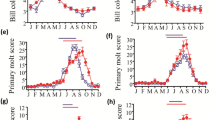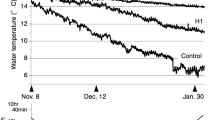Summary
-
1.
Male least chipmunks (Eutamias minimus) and yellow pine chipmunks (E. amoenus) were captured in the field and exposed to constant conditions of photoperiod (LD 8∶16, LD 12∶12, or LD 16∶8) and temperature (23° C or 5°C) for as long as 20 months. The seasonal courses of reproductive function and functions associated with hibernation were monitored by repeated measurement of testis size, body mass, water consumption, locomotor activity, and torpor.
-
2.
In the absence of seasonally changing environmental cues the chipmunks showed reproductive and hibernatory cycles that resemble rhythms of reproduction and hibernation in nature, i.e., the animals exhibited ‘endogenous circannual rhythms’. Cycles were repeated spontaneously and had a period of less than a year.
-
3.
Cycles of testis size and hibernatory functions persisted in photoperiods of LD 8∶16 and LD 12∶12, but were inhibited by LD 16∶8. Some of the animals exposed to LD 16∶8 in autumn showed brief, slight testicular development followed by regression, suggesting that there was an initial delay in the response of these animals to the negative influence of long photoperiod on testes.
-
4.
Testicular growth was promoted by warm temperature (23 °C) and retarded by cold (5 °C). Occurrence of torpor was not a requisite for the progression of the seasonal reproductive rhythm. Torpor was promoted by cold and was absent at 23 °C, but other manifestations of hibernation (decreases in locomotor activity, body mass, and water consumption) still persisted at 23 °C. Torpor of animals at 5 °C was partially inhibited by LD 16∶8.
-
5.
Endogenous annual rhythmicity should initiate preparation by chipmunks for their brief, once-a-year breeding season that follows hibernation. In addition to the peripheral responsiveness of seasonal functions to day length and temperature demonstrated by the present results, there must also be responses in chipmunks to environmental information by which the endogenous rhythmicity is synchronized with the annual environmental cycle.
Similar content being viewed by others
References
Bünning E (1973) The physiological clock. Springer, Berlin Heidelberg New York, pp 258
Davis DE (1976) Hibernation and circannual rhythms of food consumption in marmots and ground squirrels. Q Rev Biol 51:477–506
Davis DE, Finnie EP (1975) Entrainment of circannual rhythm in weight of woodchucks. J Mammal 56:199–203
Drescher JW (1967) Environmental influences on initiation and maintenance of hibernation in the arctic ground squirrel,Citellus undulatus. Ecology 48:962–966
Farner DS, Lewis RA, Darden TR (1973) Photoperiodic control mechanisms: Homoiothermic animals. In: Altman PL, Dittmer DS (eds) Biology data book, vol 2, 2nd ed. Fed Am Soc Exp Biol, Bethesda, Maryland, 1047–1052
Goss RJ (1969) Photoperiodic control of antler cycles in deer. I. Phase shift and frequency changes. J Exp Zool 170:311–324
Gwinner E (1977) Photoperiodic synchronization of circannual rhythms in the European starling (Sturnus vulgaris). Naturwissenschaften 64:44
Gwinner E (1981) Circannual systems. In: Aschoff J (ed) Handbook of behavioral neurobiology, vol 5: Biological rhythms, (in press)
Hall ER (1981) The mammals of North America, 2nd ed. Wiley, New York
Hall V, Goldman B (1980) Effects of gonadal steroid hormones on hibernation in the Turkish hamster (Mesocricetus brandti). J Comp Physiol 135:107–114
Heller HC, Poulson TL (1970) Circannian rhythms. II. Endogenous and exogenous factors controlling reproduction and hibernation in chipmunks (Eutamias) and ground squirrels (Spermophilus). Comp Biochem Physiol 33:357–383
Kenagy GJ (1979) Rapid and repeatable surgical technique for measurement of testis size in small mammals. J Mammal 60:636–638
Kenagy GJ (1980) Interrelation of endogenous annual rhythms of reproduction and hibernation in the golden-mantled ground squirrel. J Comp Physiol 135:333–339
Kenagy GJ (1981) Patterns of reproductive seasonality in three rodent species of a highland sagebrush association in central Washington, (ms)
Kenagy GJ, Bartholomew GA (1979) Effects of day length and endogenous control on the annual reproductive cycle of the antelope ground squirrel (Ammospermophilus leucurus). J Comp Physiol 130:131–136
Morrison P, Galster W (1975) Patterns of hibernation in the arctic ground squirrel. Can J Zool 53:1345–1355
Mrosovsky N (1978) Circannual cycles in hibernators. In: Wang LCH, Hudson JW (eds) Strategies in cold: Natural torpidity and thermogenesis. New York, Academic Press, pp 21–65
Mrosovsky N (1980) Circannual cycles in golden-mantled ground squirrels: phase shift produced by low temperatures. J Comp Physiol 136:349–353
Pengelley ET (ed) (1974) Circannual clocks. Academic Press, New York, p 523
Pengelley ET, Asmundson SJ (1974) Circannual rhythmicity in hibernating mammals. In: Pengelley ET (ed) Circannual clocks. Academic Press, New York, pp 95–160
Pengelley ET, Fisher KC (1963) The effect of temperature and photoperiod on the yearly hibernating behavior of captive golden-mantled ground squirrels (Citellus lateralis tescorum). Can J Zool 41:1103–1120
Pengelley ET, Aloia RC, Barnes BM (1978) Circannual rhythmicity in the hibernating ground squirrel (Citellus lateralis) under constant light and hyperthermic ambient temperature. Comp Biochem Physiol 61:599–603
Richter CP (1978) Evidence for existence of a yearly clock in surgically and self-blinded chipmunks. Proc Natl Acad Sci USA 75:3517–3521
Saunders DS (1977) An introduction to biological rhythms. Wiley, New York, pp 170
Scott GW, Fisher KC (1972) Hibernation of eastern chipmunks (Tamias striatus) maintained under controlled conditions. Can J Zool 50:95–105
Tevis L (1955) Observations on chipmunks and mantled squirrels in northeastern California. Am Midl Nat 53:71–78
Yahner RH, Svendsen GE (1978) Effects of climate on the circannual rhythm of the eastern chipmunk (Tamias striatus). J Mammal 59:109–117
Author information
Authors and Affiliations
Additional information
I thank B. Barnes and T. Horton for their technical assistance, and B. Barnes, P. Berthold, and E. Gwinner for their critical reading and discussion of the manuscript. Financial support was provided by a grant from the University of Washington Graduate School Research Fund and by National Science Foundation Grants PCM 77-05397 and DEB 77-06706. The manuscript was prepared while the author held a fellowship of the Alexander von Humboldt-Stiftung at the Max-Planck-Institut für Verhaltensphysiologie, Vogelwarte Radolfzell, Federal Republic of Germany.
Rights and permissions
About this article
Cite this article
Kenagy, G.J. Effects of day length, temperature, and endogenous control on annual rhythms of reproduction and hibernation in chipmunks (Eutamias ssp.). J. Comp. Physiol. 141, 369–378 (1981). https://doi.org/10.1007/BF00609939
Accepted:
Issue Date:
DOI: https://doi.org/10.1007/BF00609939




